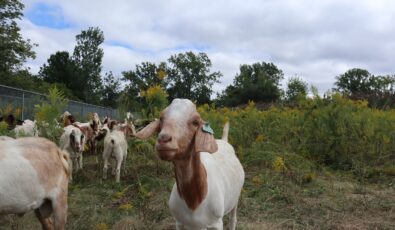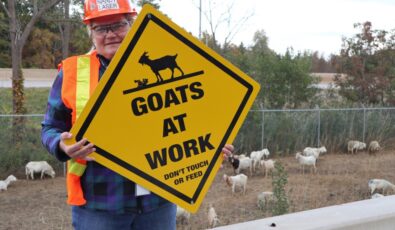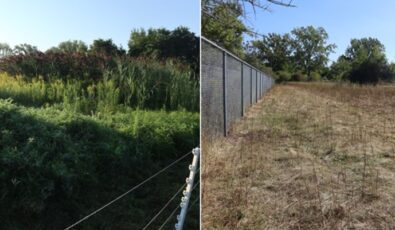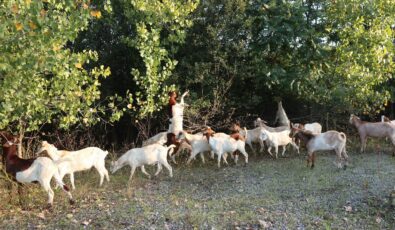Weed-chomping goats return to Niagara to keep OPG sites clear of invasive species
At a glance
- This fall, a group of 50 hungry goats have been busy keeping OPG’s Niagara Operations clear of invasive plant species and weeds.
- Now in its third season, the unique environmental program has received much acclaim and interest.
- With the goats’ help, OPG has been able to reclaim lands that are now healthier and blossoming with wildlife and native species.
They’re baa-ck.

At OPG’s sites in Niagara Falls, about 50 goats have once again been busy this September and October chowing down on invasive and fast-growing plants like phragmites and buckthorn, as well as weeds and overgrown vegetation.
Through their unique chewing power and ability to reach hard-to-reach areas, the hooved helpers have been keeping OPG’s operations in the area manageable, while reclaiming and restoring grounds for native vegetation and wildlife.
It’s the third season the goats have been deployed to graze at OPG’s Niagara sites.
And the woman behind the program, Nancy Laser, is more than pleased by the ongoing success and the positive impacts the goats have had on the lands since they first started grinding away in 2020.

“It feels really good to see the goats continuing to do great work for OPG,” said the Environmental, Chemistry, and Safety Technician. “Before the goats, in certain areas, nothing would be able to get through the phragmites. You couldn’t even walk through as the plants were 12 feet tall and as thick as my thumb. Now those areas have become a deer super-highway. We’ve seen rabbits, new bird nets, pollinators, and all kinds of animals. It’s a whole different world now.”
Laser first came upon the idea of using goats to control overgrowth during a family trip to British Columbia, where she saw goats chewing vegetation on the mountains under hydro lines.
She then spent five years researching and planning the creative initiative, including sourcing the goats from a local farmer in Welland, before launching the environmental program.
They’re absolutely changing the land, fertilizing it, and changing what grows there. These goats are doing lots of different things.Nancy LaserEnvironmental, Chemistry, and Safety Technician
Over the past three years, the goats have helped clear the lands around OPG’s Sir Adam Beck Pump Generating Station and DeCew hydro stations, and other areas, ensuring staff can safely obtain readings of water levels, water quality, and rate of flow at these sites.

The goats have also helped in controlling erosion, as they have helped avoid the use of harmful herbicides detrimental to the soil and environment. As the goats eat, their droppings act as fertilizer for the soil and the animals’ split hooves help aerate the lands. This in turn encourages the return of native grassland species to take hold to further strengthen the grounds.
Traditionally, options to remove phragmites have included digging or tearing them out, as well as applying pesticides or herbicides. Until now, these solutions required a lot of human labour that disturbed the soil, making regrowth more prone to pesky weeds.
The key advantage of using goats lies in their biology, specifically, the unique enzymes in their saliva and the bacteria in their gut. Both elements enable these animals to digest and thrive on all kinds of vegetation, including phragmites stalks, chutes, flowers, and seeds. A goat’s side-to-side chewing motion grinds the seeds, which become unviable once they pass through its digestive system.

“They’re absolutely changing the land, fertilizing it, and changing what grows there,” said Laser. “These goats are doing lots of different things.”
This season, the goats were strategically sent out to new areas around OPG’s Niagara Operations, as the lands around the Beck Pump Generating Station are now largely clear of phragmites thank to the goats’ help over the years. The goats’ focus this year has been clearing out-of-control phragmites growth at an OPG storage area along Stanley Ave. and clearing the grounds around the penstocks at the DeCew hydro stations.
As the program continues, and the goats get these invasive species under control, the strategy is also shifting, Laser said.

“It’s now about land reclamation, where we want desirable vegetation to grow on our lands, to strengthen our biodiversity program,” she said. “If we have more meadows and wetlands, there will be more pollinators. That’s our goal, to make the lands more desirable for all animals and birds and everything else.”
For Laser, she’s just happy to see the goats have been keeping busy and getting plenty to eat. She’s also happy to see the program getting so much interest and striking a chord with others outside of the company.
This summer, Laser received much praise and fielded many questions after speaking about the goat grazing program at a Wildlife Habitat Council (WHC) conference.
The program played a big role in helping OPG’s Niagara operations achieve gold certification from the WHC in 2022, which recognizes conservation excellence on corporate lands.

Recently, she has also been contacted by Niagara Parks, the City of Mississauga Parks and Forestry department, and Toyota Canada – all of whom expressed an interest in similarly deploying goats to tackle overgrowth on their lands.
It’s all validation of years of work for Laser, who remembers the program’s shaky launch, including the first day, when the goats were too afraid to come out of their trailer.
“It took a lot of struggles and convincing of skeptics to get this off the ground,” she said. “But I’m glad we thought outside the box to look at the bigger picture by launching a program that is offering so many environmental benefits for the future.”
Subscribe and stay informed
Sign up to receive the latest news, project updates, and event information from OPG.


